ABOUT US
As our church history story starts, Martin Luther Church members are hearty Christians; lively, strong and enthusiastic. Still today we are a very active congregation blessed with many members willing to give their time and talents to serve the church. We stand strong together in the belief that God’s Word is inerrant and that it is our Christian responsibility to preserve the Scriptural authority of God’s Word and to keep it sacred for future generations. In response to God’s many gifts we are enthusiastic to be his disciples and respond in faith to the call of the Holy Spirit through the Gospel and to carry out God’s mission. We welcome visitors to join us in Worship and join us in God’s work!
OUR STORY
On July 6, 1902 a group of hearty settlers assembled in the District No. 61 schoolhouse to discuss the organization of a new congregation. The majority of these individuals were former members of the neighboring congregation, St. John’s Lutheran Church. This meeting was led by Rev. J.H. Dirks of St. John’s (Stone) Church. Common understanding leads us to believe that Martin Luther Church was founded because large numbers of Lutherans in the area were traveling a great distance by horse and buggy to worship at the church along the Muddy Creek. The organization of this church was noted in the July 11, 1902, issue of the Nemaha County Herald in the following article: “A new German Lutheran church was organized last Sunday three miles west of the stone church. They expect to begin the erection of a new church as soon as possible and expect to have it completed before the first of January.”
The following individuals were the first members of Martin Luther Lutheran Church. Many of these early members still have descendants that are current members of the church. D. Holthus, Sr., August Blinde, Sr., Herman Antholz, Sr., Adolf Schneider, H.O. Blinde, John Eden, Ede Eden, John Dirks, H. Knippelmeier, Fritz Meyer, D. Ottemann, Henry Meyer, Albin Schneider, J.W. Durst, Wm. Behrends, John Casper, W. Balke, Ernst Holthus, Wm. Dirks, R. Volker, Marie Meyer, Elde Eden, Dirk Eden, Herman Rademacher, Louis Blinde, and Fred Scheele. Louis Blinde and Fred Scheele did not become members until June 1903, but are considered charter members. It is interesting to note that there is only one female shown in this list of original members. It can be assumed that many women were members of this congregation from its founding, however the tradition of the day did not encourage women to be given the full membership that the males enjoyed, hence their names were not included as official charter members.
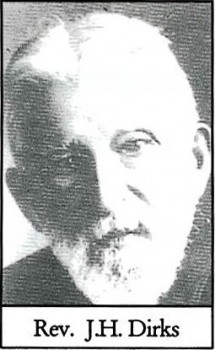
Between the time that the congregation was established in July of 1902 and the time of the building’s dedication in 1903, the members were responsible for the construction of the new church building and the building of the parsonage and barn, which took place in the early months of 1903. This house cost between $800 and $1,000. A bell for the church was purchased for 22 ½ cents per pound. It is also interesting to note that the Pastor’s salary at this point was $450.00 per year and he conducted school two months in the spring and two months in the fall. There was an established fee schedule for pastoral services. The baptism fee was $1.00 if performed at the church, $2.00 if at the house. Confirmation fee was $3.00 per member and $5.00 for a non-member. Weddings were $3.00, while funerals were $2.00. Tuition for school children whose parents were not members was at $1.00 per month paid to the pastor and 50 cents paid to the congregation.
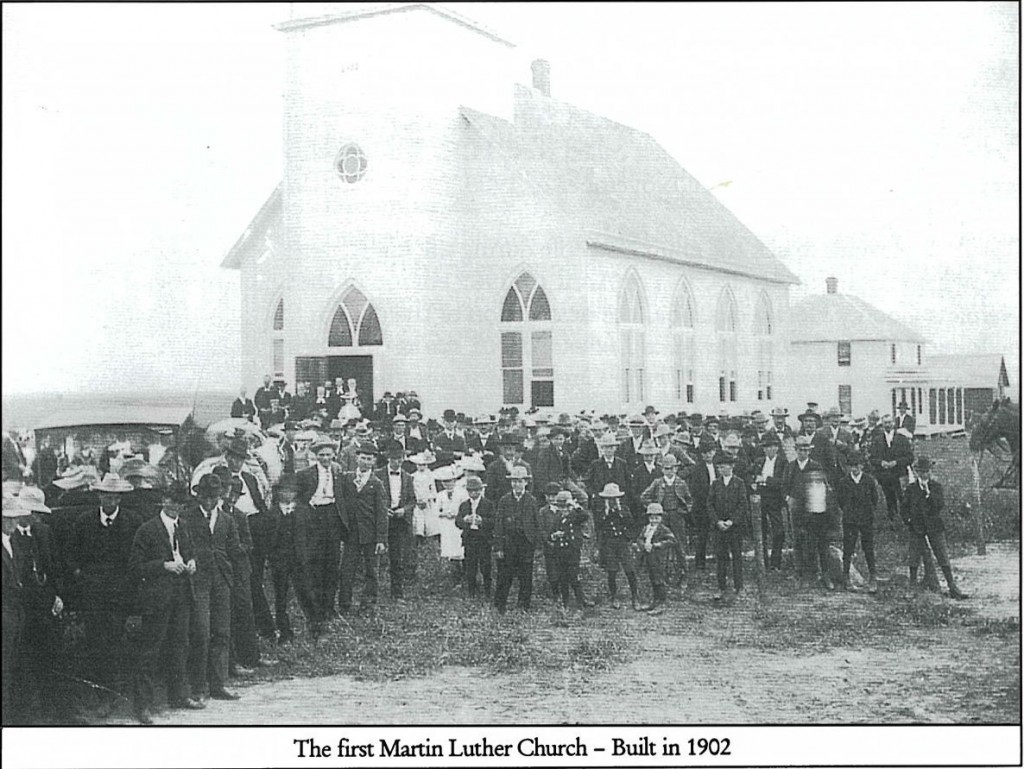
This new congregation was in need of a minister and Candidate Donath, who had just previously completed his education at the seminary, was then called to serve the young congregation. On August 30, 1903, Rev. F.M. Donath was installed and the new church was dedicated. The Nemaha County Herald of Friday August 28, 1903 had the following brief article describing this event. “A most interesting program has been prepared for the dedication of the handsome new German Lutheran church at Timber Creek next Sunday, August 30. The services will commence at 10:00 a.m. The dedicatory sermon will be preached by Rev. J.H. Dirks of Febing. The main address will be delivered by Prof. Neve, of the German department of the seminary at Atchinson, Kansas. Prof. Dirks, of Johnson will officiate as organist. At 2:30 in the afternoon Rev. Neff, D.D. or Prof. Neve will address the assemblage in English after which Rev. Winnat, of Eden, will dedicate the parsonage. The German singing society of Johnson, under the direction of Rev. F.M. Donath, will sing in German and English during the afternoon.”
In 1904, Pastor Donath severed his connection with the Nebraska Synod and applied for membership in the former Iowa Synod. The congregation approved of this step, and decided to retain Rev. Donath as pastor. He was ordained into the ministry by the neighboring pastors, Rev. Deubler of Zion Lutheran Church and Rev. Geyer of St. James Lutheran Church. It was during the year of 1904 that a new schoolhouse was built (20’ x 32’ and 12’ high) and benches were made to accommodate the students.
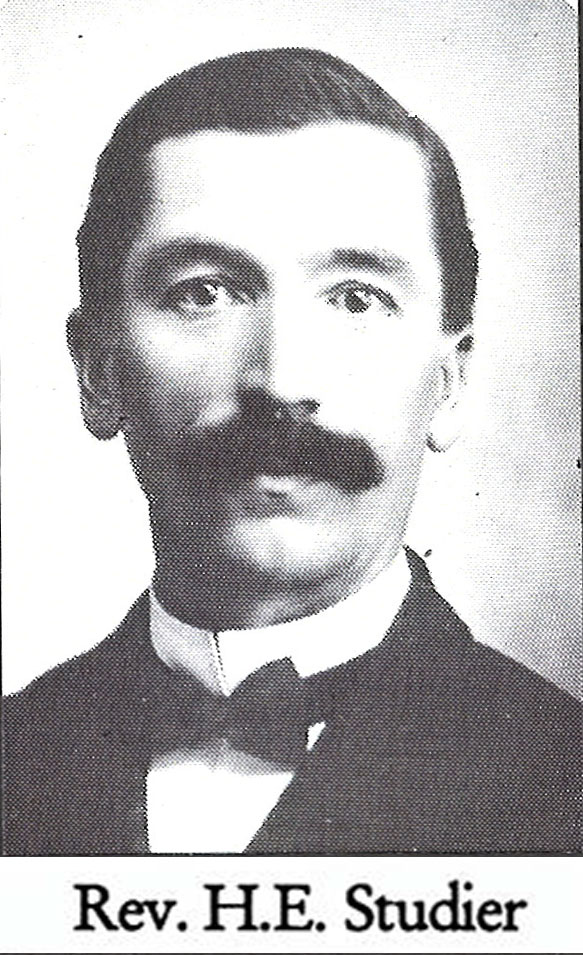
In the summer of 1905, Pastor Donath resigned his position at Martin Luther and accepted a call to Sugar City, Colorado. The congregation then called Rev. H.E. Studier who was installed by Rev. Geyer in November of 1905.
Lightning struck the church steeple during the night following Easter Sunday 1909. The April 16, 1909 edition of the Nemaha County Herald describes the destruction of the church building, “Martin Luther Evangelical Lutheran church, situated south of Johnson and locally known as the “Timber Creek” church, was struck by lightning and totally destroyed. Owing to the early hour and the suddenness of the blaze, none of the contents of the structure were saved. The church was built about five years ago, was valued at $4000 and was insured in the German Farmers Insurance Co.” The only thing that was saved from that fire was the Bible on the altar. This fire was a severe misfortune to the young congregation, but immediate steps were taken to rebuild a new church. On July 4, 1909 the cornerstone was laid. The dedication of second church took place in December 1909. This church was 30 feet wide, 46 feet long and 18 feet high. The steeple was 70 feet tall. The floor of the church sloped, one foot, from west to east. The altar area was 10 feet by 10 feet. Its lofty steeple on the hill was a landmark for people far and wide.
Pastor Studier gave his farewell address to the congregation on September 4, 1909 and moved to Sterling, Nebraska. The congregation was without a pastor for nearly a year. During this time Rev. Deubler, of the neighboring congregation, was the interim pastor.
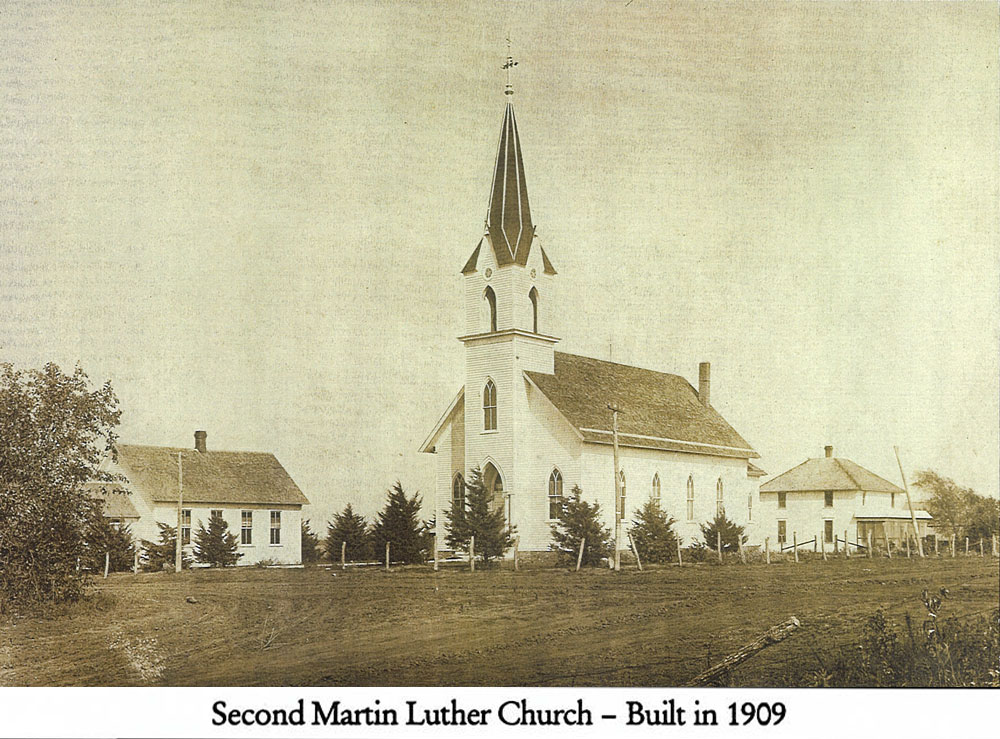
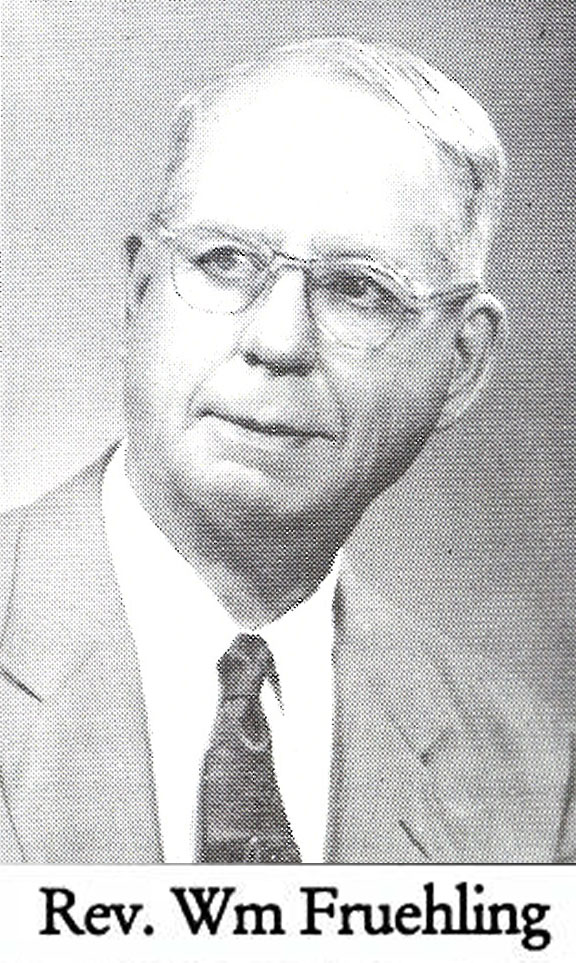
In July of 1911, a young graduate of Wartburg Seminary, Dubuque, Iowa was called to minister to the members of Martin Luther Church. This young man was Rev. William Fruehling.
The congregation built a new parsonage in 1927. During Pastor Fruehling’s tenure, many changes took place, including the gradual shift in the services from German speaking to English speaking. This gradual process began in January 1931 by having the first service of the month in English. Later in that same year it was changed to two Sundays a month. At the annual meeting on December 20, 1932, it was decided to have the worship service in English on the first and third Sundays of the month. In January of 1947, the congregation at its annual meeting approved having all the worship services in English except the first Sunday of the month and the second holiday.
The ladies of Martin Luther Church organized the First Mission Society on May 2, 1935. There were 13 ladies who took part in this organization and their main focus at that time was doing mission work for Martin Luther Home in Sterling.
The congregation had a sample copy of the church’s constitution written in English in December of 1945. In December of 1954, it was decided to have German services the first Sunday of every month before 10:30 am, which meant that for a time there were two services held on the first Sunday of the month. On December 10, 1956, regular German services were discontinued. It was not long after this that the custom of having the men sit on one side of the church and the women on the other was discontinued.
The congregation had grown from its meager beginning to an impressively sized congregation of over 220 communicants in the 1950’s. It was due to this numerical growth along with the inadequate facilities for Sunday School, social gatherings and education that it was imperative an expansion or new building be considered. The December 1950 minutes of the annual meeting showed little support for the construction of a new church, while most voting members supported the remodeling/rebuilding of the existing structure. Throughout the years of 1951-1953 much discussion was held on various ideas for dealing with the problems of the existing structure and with prayerful guidance the new church was finally approved at the August 25, 1953 meeting with the following statement: “Whereas: The money and labor must be continuously furnished and supplied as construction proceeds: We the members of Martin Luther Congregation do hereby pledge ourselves whole-heartedly to support the continuous construction of the new church with money, time and labor to bring the project to a successful conclusion to the glory of God. Adopted by unanimous approval, Aug. 25, 1953.”
On September 1, 1953, the congregation received word from the contractors, Reinke Brothers, that the old church could be dismantled beginning October 12, 1953. Working together, members tore down the old church making way for the new. The schoolhouse, which sat next to the cemetery, was used by the volunteer women to prepare the noon meal. While without a church, the congregation worshipped in the Johnson high school. Once the basement of the new church was completed, worship was held there.

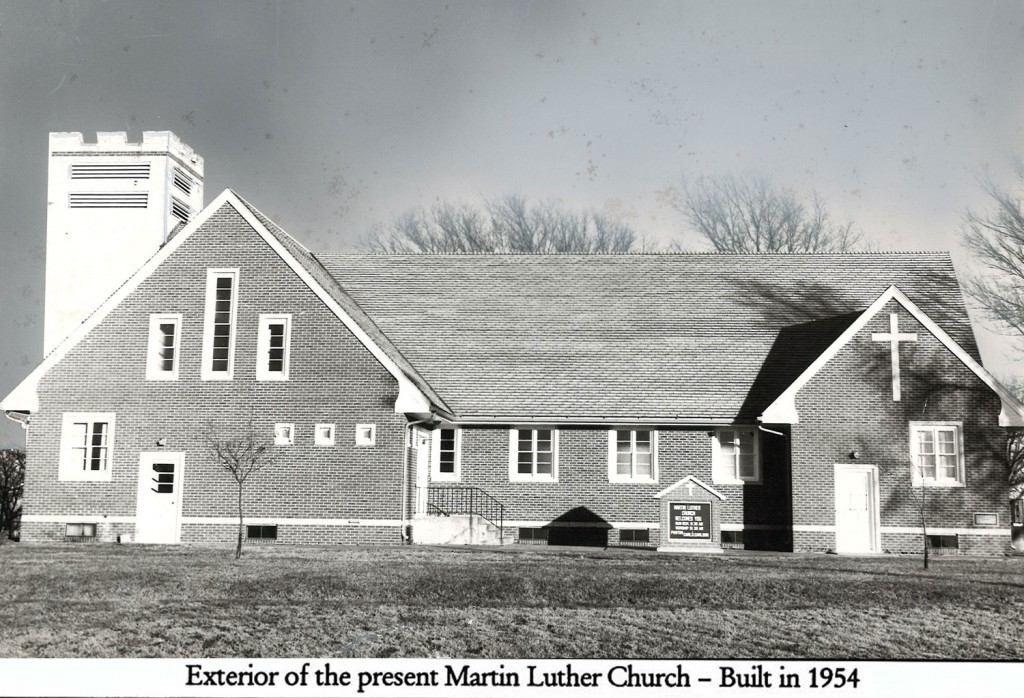
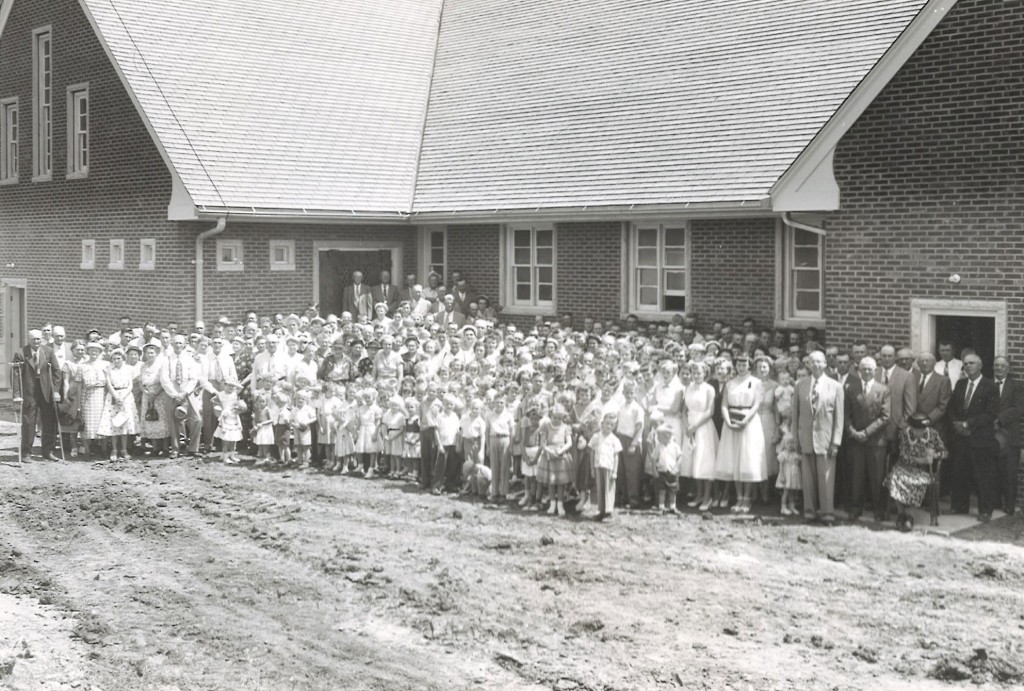
The new church was dedicated on August 29, 1954, which was also celebrated as the unofficial 50th anniversary of the congregation. The estimated cost of the church was $125,000.00.
In the 1950’s a men’s choir enhanced the worship at Martin Luther Church. As this group diminished, a mixed choir was formed in the early 1960’s. You’ll find a few of the original members included in the choir that exists today along with family of former members. All choir members can attest to the difficulty of singing with a lump in their throat for funerals of members of their church family. On the other hand, how exhilarating to sing The Hallelujah Chorus at Easter Sunrise Service! If only the church members could see high into the choir loft at various times over the years to see how choir members have had to juggle two year olds while keeping their eyes on the music and director.
As is the case in many rural churches, the farm economy has a direct impact on financial giving. Evidence of this is noted in the December, 1956 minutes “crops were poor … the Building Finance pledges shall be extended one year and if they were blessed with a fairly good crop then a drive will be held next fall to raise as much of the debt (building) as possible”.
Summer school (called German school in the early years) was conducted by Pastor Fruehling for approximately two months after the dismissal of public school. The length of the school session varied according to “when the binders came out of the shed for wheat harvest”. About that time, Pastor Fruehling would announce the end of school and Mrs. Fruehling would traditionally treat the children to a sweet snack, thus beginning a tradition that continues today. This is a shared memory of many that attended the school. As Pastor Fruehling reached his later years, one or two ladies of the church assisted him in teaching the large group of children.
It was on February 1, 1959 that a neighbor passing by late in the evening spotted a fire in the church building. The fire originated in the furnace room of the basement, burned through the main church floor, up the north wall and through a large section of the roof before the fire was brought under control. The response to the call for help was gratifying. Fire departments from Johnson, Auburn, Tecumseh, Talmage, Elk Creek, and Humboldt, as well as people from far and near, came to assist. With the temperature being 2 degrees below zero, the struggle to contain the fire was difficult. The entire church building received extensive smoke damage and water impairment, making it very difficult to clean. But once again the members of the congregation joined together to rebuild the church. During the time of renovation, the congregation held services in the basement of the church. By August of 1959 services resumed in the sanctuary.
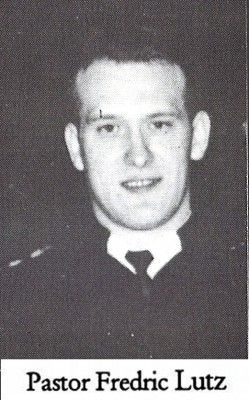
In July of 1960, Pastor Fruehling submitted his resignation to the congregation. The Fruehlings built a home in Johnson and members of the church voted to help the couple with their donations of labor during its construction.
Area pastors served the congregation until September, 1960 when Rev. Fredric Lutz was installed as pastor. He served the congregation for two years. The congregation honored Rev. and Mrs. Fruehling on July 23, 1961 with a celebration to commemorate their Golden Wedding Anniversary and Rev. Fruehling’s 50th Anniversary of his ordination into the ministry. Over 1,200 attended the services honoring the Fruehlings.
The July 23, 1961 issue of the Nemaha County Herald discussed the 49 years of service that Rev. Fruehling dedicated to this community of believers. “Rev. William R. Fruehling, who will be honored by the congregation of Martin Luther Church near Auburn this Sunday, missed conducting only one Sunday during the entire 49 years he served the church. That occasion was the result of illness. The Sunday services will honor the fiftieth ordination anniversary of Rev. Fruehling, plus the fiftieth wedding anniversary of the pastor and his wife.
Installed as pastor on July 30, 1911, Rev. Fruehling had led the congregation in steady and constant growth. A rural church located nine miles west and four miles south of Auburn, it grew from a membership of about 80 confirmed members in 1911 to 227 confirmed members at present, with an additional 125 under the age of 14.
The honored couple has earned the respect and admiration of the entire area for their unselfish service to the church and community. They retired on July 3, 1960 because of ill health”.
In 1960, the congregation revised the church’s constitution. The Parish Education Committee was created under the By-laws of the Constitution at this time and given the responsibility to provide for the Christian education of the congregation.
An Altar Guild Committee was also established in 1960. Their first project was to create paraments and linens for the altar and communion ware. A special cabinet was built to store the communion ware. Changes in the worship service included the decision to change from the common cup to individual cups at the Lord’s Supper. The practice of having acolytes assigned to light the candles originated at this time. The Altar Guild began the tradition of making baptismal “hankies”. For the last 41 years, young and old have received the cloth embroidered with their name that was used the day they were baptized into God’s family. For the last 17 years, the newly baptized have also received a baptismal banner reminding them of that important event when the Holy Spirit announces “You Are Mine” (Mark 1:11.)
The Ladies Mission Society re-organized in 1961 becoming the Martin Luther Church Women and creating four circles for Bible study. That year, they donated the materials and Pastor Lutz built the mailboxes located in the narthex. Over the years this has proven to be an interesting addition, as “leave it in my mailbox” remains a familiar and on-going saying around the church family yet today. The bulletin board incorporated with the mailboxes reminds us of upcoming events or leaves us with an inspiring message.
In 1961 the congregation approved the Junior Lutheran program of study for the 4th, 5th, and 6th grades in preparation for Confirmation classes in the 7th & 8th grades. This education program continued for over 20 years.
While the charter members of the church were mostly men, sixty years later it is noted in the minutes that “maiden women and widows be encouraged to sign the Constitution.” When the Parish Education Committee was formed in 1961, the minutes read, “at least one member should be a lady”. It was 27 years later when the first woman was elected to the church council. Today women of the church are instrumental in all aspects of the organization and happenings of the church.
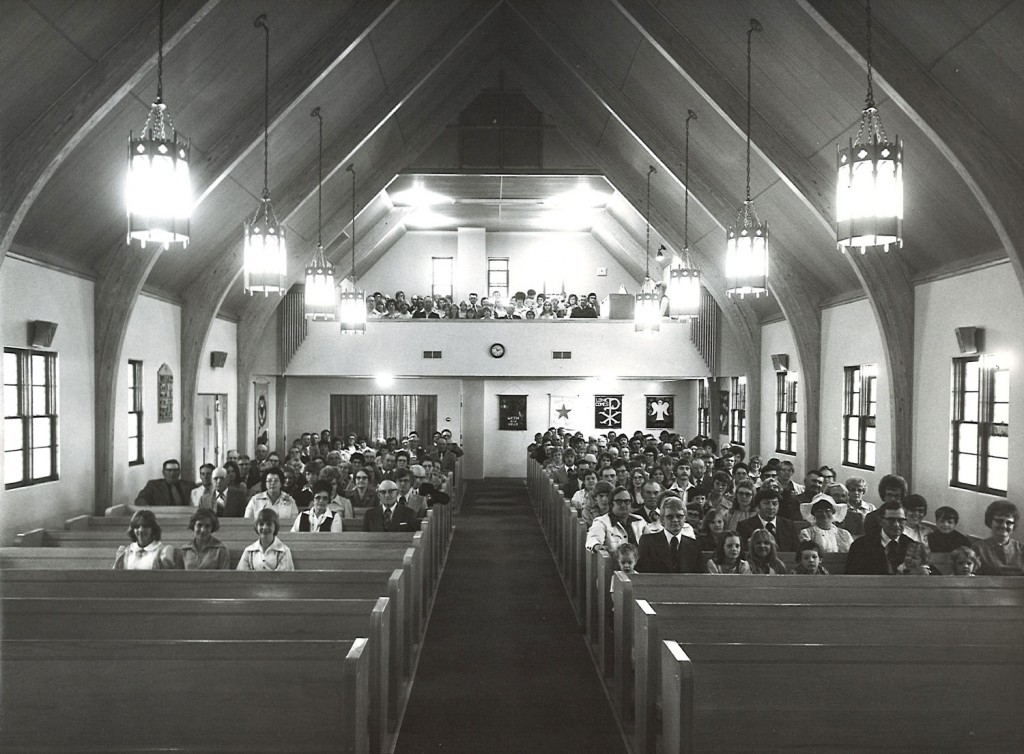
From September 1962 until May 1963, Rev. Duerschner served the congregation as the Interim Pastor. On May 19, 1963, Pastor Carl O. Carlson was installed as pastor of Martin Luther. It was during his ten years at Martin Luther that the congregation was at its peak membership with 330 baptized members and 256 confirmed.
On January 6, 1964, the church building was declared debt free at the annual meeting, just ten years after construction began. Throughout the 1960’s the congregation continued to improve the church property by removing the old garage, chicken house, and barn, replacing them with a new double garage.
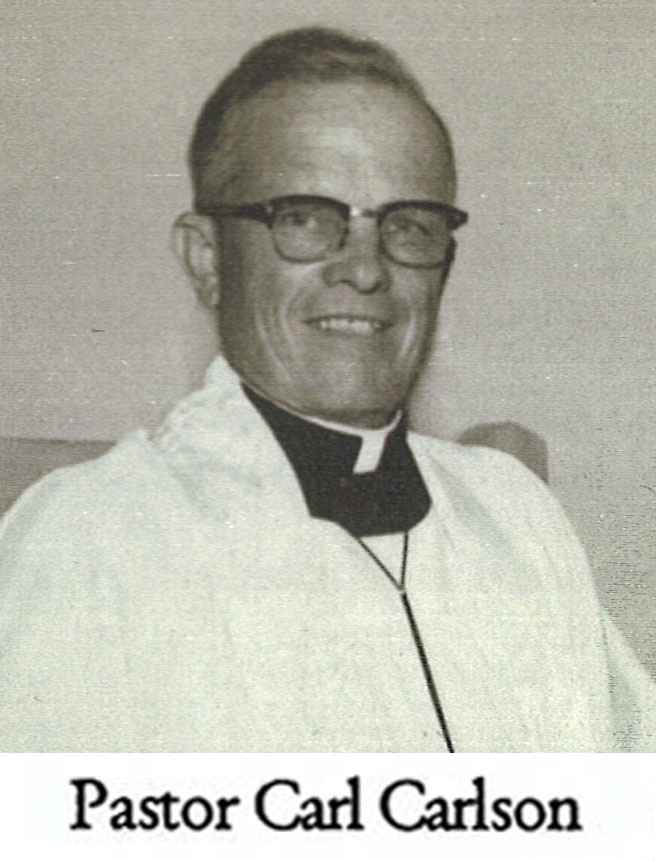
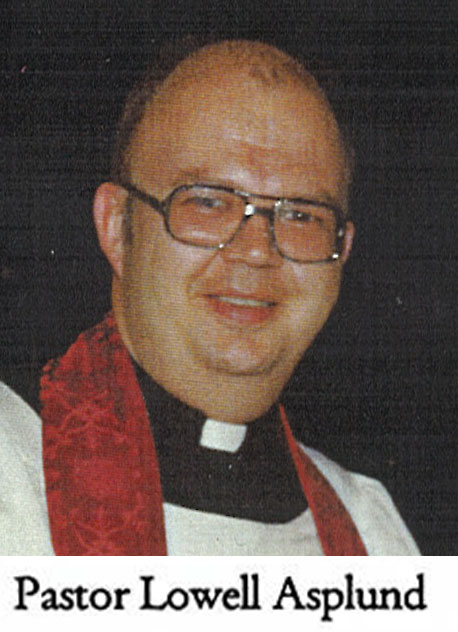
Pastor Carlson resigned in 1972 to retire with his wife, Esther in Springfield, Missouri. From December 1972 until July 1973, the congregation was again without a pastor and was served by local pastors, as well as Pastor Gary Powers for a three-month period. On August 5, 1973, Pastor Lowell Asplund was installed as pastor of Martin Luther. In 1975, the congregation began the custom of having greeters before the church services.
A Young Couples group organized in 1973, meeting for Bible study and socially for events like picnics, games and eating out, often sharing fellowship with groups from other churches. Eventually in the 1980’s, this group evolved to a single event, a progressive dinner, still held in December of each year.
It was on July 10, 1977, that the congregation celebrated its 75th anniversary. The Nemaha County Herald reported “More than 600 attended the morning service, at which Rev. Eldor Fruehling spoke. Rev. Walter and Rev. Richard Fruehling spoke at the afternoon service. All proceedings were visible to the crowd by means of closed circuit television to a large tent on the lawn, where receivers and sound allowed full participation.”
It was in May of 1979 that Pastor Asplund and his wife, Sharon and son moved to a church in Minnesota to be closer to their family. A short time later, in September of 1979, Pastor Will Hazard was installed as the pastor of Martin Luther. He and his wife, Eva, remained with the congregation until January 1984, when they moved to serve a church in Utah.
In 1983 the existing Cemetery Committee was given an additional responsibility to maintain the newly established cemetery perpetual fund. The cemetery was expanded in 1997, which allowed space for a windbreak to the north.
Over the years, the confirmation students and younger children of the church have attended church camp. Circle R and Camp Carol Joy Holling have proven to be an inspiration to these young people as well as a time for some confirmation instruction. The many organizations of the church have been instrumental in providing financial help to these young campers.
The Summer School of the church’s first 60 years later evolved into a two-week Vacation Church School. In 1961, it boasted an enrollment of 86 with the assistance of many volunteer teachers. In the middle 1970’s, Martin Luther and St. James combined their Bible school programs for a number of years due to low enrollment. As the schedule was shortened to one week, the length of the day still provided for the students to be able to take and eat their sack lunches at church, enjoying the noon recess in various ball games. This became a favorite memory of many of our young people. Days were shortened to half days in the early 1990’s but still included the picnic on the final day complete with water fights and a lively program on the following Sunday.
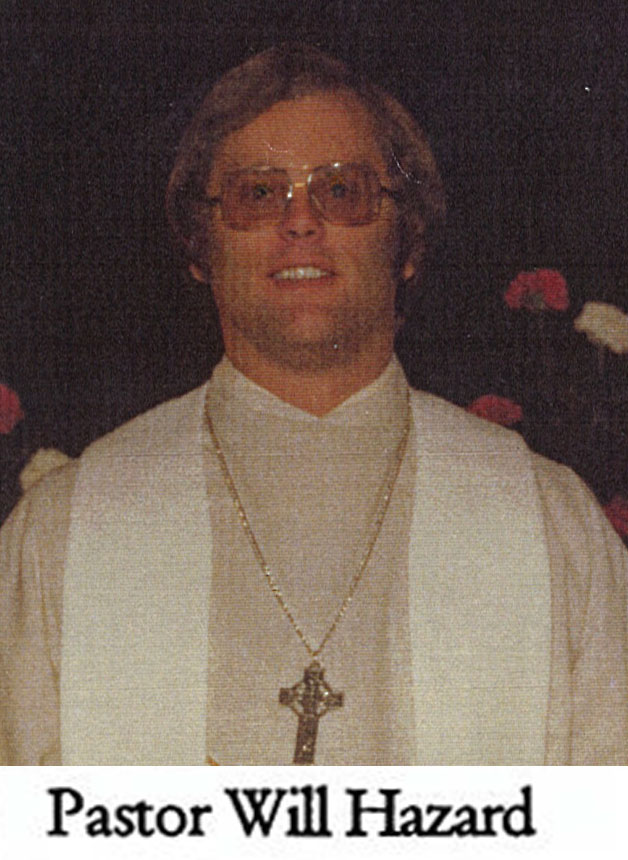

Pastor Daniel Zellmer was called to Martin Luther in July of 1984. The practice of having a lay person assist in serving of the Lord’s Supper began during 1984. In 1987, the congregation voted to become a member of the Evangelical Lutheran Church in America (ELCA) that had been formed by the merger of three predecessor Lutheran church bodies, one of which was the American Lutheran Church that Martin Luther Church had been a member of prior to the unification. The congregation voted at this time to alter the Confirmation program by extending it one year to include the 6th grade and having communion instruction during that grade with Holy Communion offered to them at the completion of this instruction. Pastor Zellmer was called to a church in Victoria, Texas, where he moved with his wife, Debbie and their three daughters in March 1989.
The congregation was without a full-time pastor for 15 months, but was served by Interim Pastor Keith McKay and also Pastor Josephson of nearby Zion Church. Within the next three years, the look of the church interior changed when carpet was installed in the sanctuary and balcony, pew cushions were added, and glass doors were installed at the entrance.
Pastor James Killough was installed at Martin Luther in June of 1990. The practice of having laypersons serve as lectors was initiated and we began to rotate between receiving Holy Communion as a “table” or in “continuous” fashion. In 1994, the congregation created the Worship and Stewardship committees to fulfill the mission of the church. An illuminated cross on the top of the bell tower was also added in 1994. Pastor Killough, his wife Deb, and two sons left Martin Luther in May 1995, accepting a call from St. Timothy’s Lutheran Church in Omaha, Nebraska.

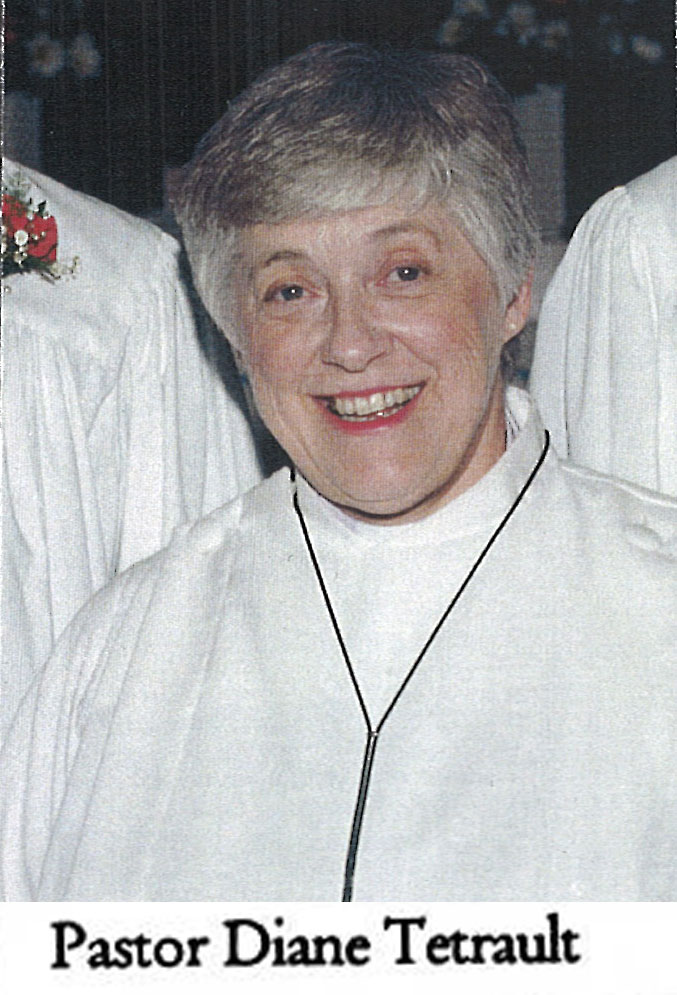

Shortly thereafter in September of 1995, Pastor Diane Tetrault arrived to serve at Martin Luther. In 1994 the congregation formed a committee to look into making the church more handicap accessible and one of the first results of this was adding the ramp to the main church entrance in 1997. In July of 1997, Pastor Tetrault resigned to accept a call near her family in Wisconsin.
Pastor Edi Bickford from Hickory Grove church served as Interim Pastor until the arrival of our current minister, Pastor Amy Krejcarek. Pastor Amy was called to the congregation following the completion of her seminary education. She was installed in April of 1998. Throughout the years, Martin Luther Church has appreciated the sharing of pastors during times of vacancies. We also enjoy the participation of the round robin Lenten Services with several local churches and, through different times during our history, the sharing of various types of services with the St. John’s (Stone), St. Paul’s Hickory Grove, and Zion churches. Confirmation classes have been combined at various times with these churches. The long history with St. James Long Branch Church also includes the shared Mission Festivals and fellowship meals following.
Within the past two years, the congregation has taken further steps to make the building more accessible by adding an elevator entrance into the basement and a handicap accessible restroom on the main floor. The stained glass windows as well as central air conditioning have been other recent additions.
For one hundred years the people of Martin Luther have united to serve the Lord. They have done this through church services and strong fellowship programs. Martin Luther continues a number of traditions from the past such as the children’s Nativity program and the candlelight service on Christmas Eve.

The Brotherhood, now referred to as the Men of the Church, began in 1950 as a group for Bible Study and missionary projects. Over its 50 years, it has also supported the upkeep and various renovation projects of the church. Long ago, it began the tradition of having an annual pancake feed, raising money for its various projects. In recent years, one cannot resist the aroma of the men outdoors grilling the sausage and the enticement of the pancakes rotating on their homemade pancake griddle. While in the last few years the men of the church have not had a formal organization, they have never failed to come together for another successful pancake dinner or workdays for church maintenance. In 2002, they were the driving force for organizing and conducting a consignment sale to raise funds for the Centennial celebration and were also busy installing an attractive fence on the cemetery.
The Luther League, another long time organization, dates back to 1927. Christmas caroling has been a favorite tradition of the youth group. They have been regular contributors for projects updating the church, as well as many mission projects. Former league members from the 1950’s recall monthly meetings that included Bible study and activities such as ping-pong, shuffleboard, and ice cream socials. They also attended Southeast Nebraska youth rallies, took yearly outings to Lincoln and attended roller skating parties in Nebraska City. In the 1970’s they were sponsors of annual soup suppers and in 1982, revived the summer ice cream social. Youth of the last 20 years have had a chance to turn the crank of the ice cream freezer while looking forward to a taste at the end of the ice-cream making evening and serving up the ice cream varieties with pies and cakes at their fund raiser. For the past decade, the youth have provided breakfast following the Easter sunrise service. Recent memories have been made with trips canoeing, skiing or to Worlds of Fun.
The Martin Luther Church Women condensed their four circles created in the 1961 re-organization down to two in 1962, with the Naomi-Ruth Circle meeting monthly in the afternoon and the Faith-Hope Circle meeting in the evening. Later, in 1985, the Tabitha Circle was formed and the three circles continue yet today. Work groups were also formed in the 1980’s, which allow all age groups to work together, and proved to be beneficial in projects sponsored by the Women of the ELCA, as they are now called. They have been instrumental in funding kitchen updates as well as being generous contributors towards many other church and parsonage renovations. The women’s group has sponsored the annual soup supper/dinner since 1982 as well as many mother-daughter events, guest nights, conferences, and golden-age dinners. The Family Christmas Supper of the past turned into the Advent-Christmas Dinner. It has been a part of church families’ calendars for many years and brings families together for fellowship and service projects. At the event this past year in honor of the upcoming 100th year anniversary of the church, over 100 toys were collected and given to a local charity for needy families. Some of the mission projects that this group has supported during its years of existence include collecting items for the needy and Lutheran World Relief.
The “Sewing Ladies” are another proud organization of the church. They meet weekly except during the summer to sew, tie and/or quilt pieces of fabric together into beautiful blankets that are then sent through Lutheran World Relief to people in need, to local charity organizations, and to local care homes. These past several years, the ladies have graced our young people graduating from high school with blankets to take with them wherever they may venture, remembering along the way the warm memories of growing up in the Martin Luther Church family.
Over the course of its 100 years, the church and its organizations have depended on donations – monetary, material, and time – from its church members and many others. With these contributions, the church has been furnished and renovated from time to time with the necessary elements to continue onward. Although too numerous to mention, each and every one were greatly appreciated.
As we continue onward, the memories are wonderful and the future remains hopeful. Most of all we are thankful of the Lord’s blessings in the last 100 years and look forward to His future guidance and grace as we continue in the years ahead to “Lift High The Cross.”
